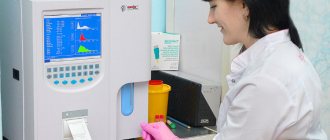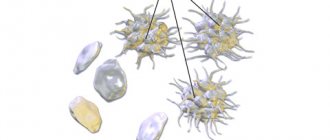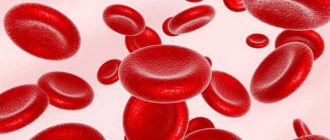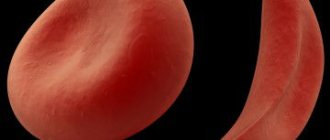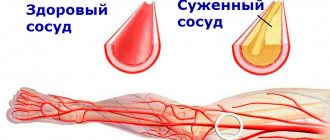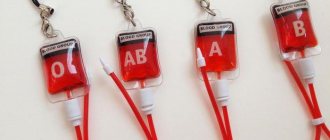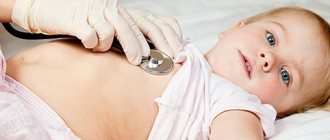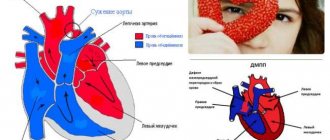© Author: A. Olesya Valerievna, candidate of medical sciences, practicing physician, teacher at a medical university, especially for SosudInfo.ru (about the authors)
The heart is one of the main “workers” of our body. Without stopping for a minute throughout life, it pumps a gigantic amount of blood, providing nutrition to all organs and tissues of the body. The most important characteristics of the efficiency of blood flow are the minute and stroke volume of the heart, the values of which are determined by many factors both from the heart itself and from the systems that regulate its functioning.
Minute blood volume (MBV) is a value characterizing the amount of blood that the myocardium sends into the circulatory system within a minute. It is measured in liters per minute and equals approximately 4-6 liters at rest with the body in a horizontal position. This means that the heart can pump all the blood contained in the vessels of the body in a minute.
Stroke volume of the heart
Stroke volume (SV) is the volume of blood that the heart pushes into the vessels during one contraction. At rest in the average person it is about 50-70 ml. This indicator is directly related to the condition of the heart muscle and its ability to contract with sufficient force. An increase in stroke volume occurs as the pulse increases (up to 90 ml or more). In athletes, this figure is much higher than in untrained individuals, even if the heart rate is approximately the same.
The volume of blood that the myocardium can throw into the great vessels is not constant. It is determined by the requests of authorities in specific conditions. So, during intense physical activity, anxiety, or in a state of sleep, organs consume different amounts of blood. The influences on myocardial contractility from the nervous and endocrine systems also differ.
As the heart rate increases, the force with which the myocardium pushes out blood increases and the volume of fluid entering the vessels increases due to the significant functional reserve of the organ. The reserve capacity of the heart is quite high: in untrained people, during exercise, cardiac output per minute reaches 400%, that is, the minute volume of blood ejected by the heart increases up to 4 times, in athletes this figure is even higher, their minute volume increases 5-7 times and reaches 40 liters per minute.
How to increase the stroke volume of the heart. Stroke blood volume (SV)
The amount of blood ejected from a ventricle of the heart in one heartbeat is called stroke volume (SV).
At rest, the stroke volume of blood in an adult is 50-90 ml and depends on body weight, the volume of the heart chambers and the force of contraction of the heart muscle. The reserve volume is the portion of blood that remains in the ventricle at rest after contraction, but is expelled from the ventricle during exercise and stressful situations. It is the magnitude of the reserve blood volume that significantly contributes to the increase in stroke volume during physical activity. An increase in stroke volume during physical activity is also facilitated by an increase in venous return of blood to the heart. When transitioning from a state of rest to performing physical activity, the stroke volume of blood increases. The SV value increases until its maximum is reached, which is determined by the volume of the ventricle. With very intense exercise, the stroke volume of blood may decrease, since due to a sharp shortening of the duration of diastole, the ventricles of the heart do not have time to completely fill with blood.
When transitioning from a state of rest to exercise, SV quickly increases and reaches a stable level during intense rhythmic work lasting 5-10 minutes, for example during physical training.
The maximum value of stroke volume is observed at a heart rate of 130 beats/min. Subsequently, with increasing load, the rate of increase in stroke volume of blood sharply decreases and, at a work power exceeding 1000 kgm/min, it is only 2-3 ml of blood for every 100 kgm/min increase in load. With prolonged and increasing loads, the stroke volume no longer increases, but even decreases somewhat. Maintaining the required level of blood circulation is ensured by a higher heart rate. Cardiac output increases mainly due to more complete emptying of the ventricles, i.e., by using the reserve volume of blood.
Minute blood volume (MBV) shows how much blood is ejected from the ventricles of the heart within one minute. The minute volume of blood is calculated using the following formula:
Minute blood volume (MBV) = SV x heart rate.
Since in healthy adults, the stroke volume of blood (hereinafter, when comparing the parameters of untrained people and athletes, see Table 1) is 50-90 ml at rest, and the heart rate is in the range of 60-90 beats/min, the value of minute blood volume at rest it is in the range of 3.5-5 l/min.
Table 1. Differences in the reserve capabilities of the body in an untrained person and an athlete (according to N.V. Muravov).
after maximum load B
after maximum load B
1. Heart rate per minute
2. Systolic blood volume
3. Minute blood volume (l)
In athletes, the value of minute blood volume at rest is the same, since their stroke volume is slightly higher (70-100 ml), and their heart rate is lower (45-65 beats/min). When performing physical activity, the minute volume of blood increases due to an increase in the value of the stroke volume of blood and heart rate. As the amount of physical activity performed increases, the stroke volume of blood reaches its maximum and then remains at this level with a further increase in the load. The increase in minute blood volume under such conditions occurs due to a further increase in heart rate. After cessation of physical activity, the values of central hemodynamic parameters (MOC, SV and heart rate) begin to decrease and after a certain time reach the initial level.
In healthy, untrained people, the minute volume of blood during physical activity can increase to 15-20 l/min. The same magnitude of IOC during physical activity is observed in athletes developing coordination, strength or speed.
For representatives of team sports (football, basketball, hockey, etc.) and martial arts (wrestling, boxing, fencing, etc.), the IOC value under load is in the range of 25-30 l/min, and for elite level athletes reaches maximum values (35-38 l/min) due to the large stroke volume (150-190 ml) and high heart rate (180-200 beats/min).
During moderate-intensity physical activity in a sitting and standing position, IOC is approximately 2 l/min less than when performing the same load in a lying position. This is explained by the accumulation of blood in the vessels of the lower extremities due to the force of gravity.
During intense exercise, the minute volume can increase 6 times compared to the resting state, and the oxygen utilization rate can increase 3 times. As a result, the delivery of O2 to tissues increases approximately 18 times, which allows, during intense exercise in trained individuals, to achieve an increase in metabolism by 15-20 times compared to the level of basal metabolism.
The so-called muscle pump mechanism plays an important role in the increase in minute blood volume during physical activity. Muscle contraction is accompanied by compression of the veins in them, which immediately leads to an increase in the outflow of venous blood from the muscles of the lower extremities. Postcapillary vessels (mainly veins) of the systemic vascular bed (liver, spleen, etc.) also act as part of the general reserve system, and contraction of their walls increases the outflow of venous blood. All this contributes to increased blood flow to the right ventricle and rapid filling of the heart.
When performing physical work, the IOC gradually increases to a stable level, which depends on the intensity of the load and ensures the required level of oxygen consumption. After stopping the load, the IOC gradually decreases. Only during light physical activity does an increase in minute volume of blood occur due to an increase in stroke volume and heart rate. During heavy physical activity, it is provided mainly by increasing the heart rate.
Blood pressure readings
Systolic blood pressure (SBP) converted to the auscultatory method:
SAD = SADf * K
where:
SADf – actual (invasive) systolic blood pressure is determined by the position of point “e” on the oscillogram.
K is an empirical coefficient.
Diastolic blood pressure (DBP) converted to auscultatory method:
DBP = DADf * K
Where:
DAPf – actual (invasive) diastolic blood pressure is determined by the position of point “b” on the oscillogram.
K is an empirical coefficient.
Mean hemodynamic blood pressure (MAP)
The integral value of all types of blood pressure reflects their average level during the full cardiac cycle. This is the driving force of blood flow. Determined by point “c” on the oscillogram.
Lateral systolic blood pressure (LSBP)
Blood pressure experienced by the inner surface of the vascular wall of an artery during systole. It corresponds to the moment when the maximum possible volume of blood penetrates into the compressed arterial vessel, expelled at the highest speed. Determined by point “d” on the oscillogram.
Pulse blood pressure (PBP)
ADP = SAD - DBP
Shock blood pressure (BP)
ADud = SADf - dietary supplement
Wednesday, December 24, 2014
Stroke volume of the heart
A common person:
Stroke volume – 60-90 ml. Pulse rate during exercise – 150 beats per minute Minute volume (pumped per minute) – 9-13.5 liters
Athlete:
Stroke volume – 150-200 ml. Pulse rate during exercise – 150 beats per minute Minute volume (pumped per minute) – 22.5-30 liters
How to increase the stroke volume of the heart?
Workouts at 120-130 heart rate
INFLUENCE OF TEMPERATURE ON GROWTH HORMONE (GH)
Staying in high temperatures significantly increases the content of somatotropin in the blood. For example, while staying in a sauna, the level of growth hormone in the blood increases 2-3 times; you just need to use this temperature stimulator correctly. In the sauna you need to steam a little every day - from 5 to 15 minutes. Otherwise, serious changes in metabolism will not be achieved. The minimum frequency of visiting the sauna, which gives an anabolic effect, is 3 times a week. A weekly many-hour stay in a sauna with numerous visits from a physiological point of view does not make any sense. In practice, a Russian steam bath has shown even greater efficiency than a sauna. Even in Finland, where visiting a sauna is a cult, Finns are abandoning saunas and building Russian baths.
Correct use of higher temperatures leads to increased anabolic processes with simultaneous “burning” of subcutaneous fat tissue. This is a good sign indicating an increase in GH secretion. When the body overheats, a very interesting phenomenon occurs, which is called “centralization of blood circulation.” Due to overexcitation of the sympathetic-adrenaline system and the release of a huge amount of adrenaline into the blood, a very strong narrowing of all peripheral vessels and expansion of the central ones occurs. Constriction of blood vessels in the periphery reduces the thermal conductivity of the skin and prevents excess heat from penetrating to the central organs. Increased combustion of subcutaneous fat tissue is partly due to a strong narrowing of not only skin, but also subcutaneous vessels, which disrupts blood circulation in the subcutaneous fat tissue.
Neurotransmitters that cause centralization of blood circulation are at the same time inducers of somatotropin release. In a steam bath or sauna at an air temperature of 110 degrees Celsius, the level of somatotropin in the blood can increase 6 (!) times. Let's not forget that somatotropin is a stress hormone and its release is induced by any more or less serious stress. Somatotropin mobilizes fatty acids from subcutaneous fat into the blood and switches mitochondria from carbohydrate to fat type of nutrition to increase their vitality. After all, mitochondria are the youngest formations of the cell in evolutionary terms and suffer first of all. Somatotropin protects them from destruction. If adrenaline and glucocorticoid hormones in excess quantities during severe stress can damage cellular structures, then somatotropin never does. On the contrary, it prevents the damage to cell membranes that can occur due to excess adrenaline and glucocorticoids.
An additional positive effect of the sauna is a gradual decrease in basal metabolism, which slows down the catabolic processes in the muscles, and muscles, as is known, grow by 60% due to a slowdown in catabolism, and only 40% due to an increase in anabolism. The same can be said about such qualities as endurance and the ability to recover after heavy physical exertion. Development of endurance, incl. and strength, in general, 70% depends on slowing down catabolism. Increasing endurance allows you to use large training loads and, ultimately, increase anabolism indirectly. The cornerstone in this case is, naturally, an increase in the secretion of growth hormone.
Literature
- Hydrodynamics of blood circulation. Collection of translations edited by Regirer S.A. – M.: Mir, 1971. – 271 p., ill.
- Caro K., Pedley T., Schroter R., Sid U. Mechanics of blood circulation: Trans. from English - M.: Mir, 1981. - 624 p., ill.
- Hardware-software complex for non-invasive study of central hemodynamics using volumetric compression oscillometry “CAP CG osm-“Globus”. Instructions for use. Belgorod. LLC "Globus" 2004. – 51 p.
- Pedley T. Hydrodynamics of large blood vessels: Trans. from English – M.: Mir, 1983. – 400 pp., ill.
- Savitsky N.N. Some methods of research and functional assessment of the circulatory system. – L.: Medicine, 1956. – 329 p., ill.
- Fofanov P.N. Textbook on mechanocardiography. – L.: VMedA im. S.M.Kirova, 1977. – 111 p., ill.
- Eman A.A. Biophysical basis for measuring blood pressure. - L.: Medicine, 1983. – 128 p., ill.
